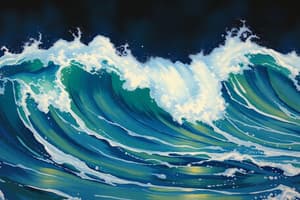Podcast
Questions and Answers
What describes the movement of particles in a compressional wave?
What describes the movement of particles in a compressional wave?
- Particles move up and down.
- Particles follow a circular motion.
- Particles move left and right.
- Particles are pushed together and spread apart. (correct)
What is the crest of a transverse wave?
What is the crest of a transverse wave?
- The point where particles are at rest.
- The highest point of the wave. (correct)
- The area of compression in the wave.
- The lowest point of the wave.
What happens to particles of a medium after a wave passes through?
What happens to particles of a medium after a wave passes through?
- They compress together and do not return.
- They oscillate around their original position. (correct)
- They move permanently to a new position.
- They remain stationary permanently.
Which of the following statements correctly describes both transverse and compressional waves?
Which of the following statements correctly describes both transverse and compressional waves?
What is the area called where particles are spread apart in a compressional wave?
What is the area called where particles are spread apart in a compressional wave?
What is the speed of sound in seawater?
What is the speed of sound in seawater?
How does sonar determine the location of an object?
How does sonar determine the location of an object?
Which medium has the highest speed of sound according to the information provided?
Which medium has the highest speed of sound according to the information provided?
What is the primary application of sonar technology mentioned?
What is the primary application of sonar technology mentioned?
What happens to the speed of sound as it travels from air to fresh water?
What happens to the speed of sound as it travels from air to fresh water?
Flashcards are hidden until you start studying
Study Notes
Types of Waves
- Transverse waves involve particle movement up and down, with crests and troughs as key features. In these waves, the particles of the medium move perpendicular to the direction of the wave propagation. This results in characteristic visuals where crests (the highest points) and troughs (the lowest points) can be observed. Common examples of transverse waves include light waves and waves on strings.
- Compressional waves, also known as longitudinal waves, display left and right particle movement, forming areas of compression and rarefaction. In compressional waves, particles of the medium oscillate parallel to the wave direction. This creates areas where particles are crowded together (compression) and areas where they are spread apart (rarefaction). A classic example of compressional waves is sound waves traveling through air or liquids.
- Waves transfer energy along with a medium with minimal particle displacement. This means that while waves can move energy across vast distances, the medium's particles occupy relatively fixed positions around their equilibrium states. The energy transfer facilitated by waves is fundamental in various physical phenomena and technological applications, from communication technologies to energy generation.
Wave Features
- The crest represents the highest point of a transverse wave, where the maximum displacement of the medium occurs. This point indicates the peak value of the wave's amplitude, which is crucial in determining the wave's energy. Similarly, the trough, the lowest point, corresponds to the minimum displacement.
- The speed of sound varies across different media, influencing how sound is transmitted through various substances:
- Air: 334 m/s – sound travels faster in warmer air due to greater particle energy.
- Freshwater: 1,461 m/s – water's denser molecular structure impacts sound speed positively.
- Seawater: 1,490 m/s – the salt content in seawater also plays a role in increasing the speed of sound compared to freshwater.
- Glass: 5,000 m/s – the tightly packed molecules in glass facilitate rapid sound wave transmission.
- Silver: 2,610 m/s – as a metal, silver allows for faster sound transmission due to its conductive properties.
- Sonar technology utilizes reflected sound waves for mapping and locating underwater objects. This method employs the principles of echolocation, where sound waves emitted by a device bounce off objects and return to the source, providing valuable information about the location and distance of these objects. It is widely used in navigation, fishing, and underwater exploration.
Sound Wave Properties
- Sound waves travel faster in deeper water compared to shallow water. The enhanced speed can be attributed to factors such as increased pressure and temperature at greater depths, which allow sound waves to propagate through the medium more effectively.
- Refraction alters wave direction due to changes in the medium; sound waves refract when transitioning from air to water. This bending of waves is critical in various applications, such as underwater communication and navigation, as it affects the perceived locations of objects and underwater signals.
- Hard surfaces reflect sound well, while soft surfaces absorb sound. This distinction is significant in architectural acoustics, where the types of materials used in a space can affect the sound environment, impacting clarity and reverberation of sounds, which is crucial for concert halls, studios, and other venues.
Volume and Pitch
- Volume is determined by amplitude, with larger amplitudes producing louder sounds. The amplitude of a sound wave indicates its energy level; thus, greater amplitude corresponds to louder perceptions of sound, while smaller amplitudes lead to quieter sounds.
- Volume is measured in decibels (dB), which is a logarithmic unit representing the intensity of sound. For perspective, a whisper typically registers at around 30 dB, regular speech is about 60 dB, and sounds above 90 dB can lead to potential hearing damage with prolonged exposure. This scale helps in understanding and regulating sound exposure in various environments.
- Pitch changes are perceived differently based on movement relative to the sound source, as observed with a passing car. This phenomenon,
Studying That Suits You
Use AI to generate personalized quizzes and flashcards to suit your learning preferences.




